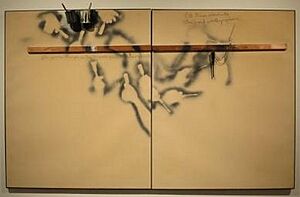Jim Dine facts for kids
Quick facts for kids
Jim Dine
|
|
|---|---|

Dine in 2020
|
|
| Born |
James Lewis Dine
June 16, 1935 Cincinnati, Ohio, U.S.
|
| Education | Ohio University University of Cincinnati |
| Known for | painting, drawing, sculpture, printmaking, photography, happenings, assemblage, poetry |
| Spouse(s) | Nancy Lee Minto |
Jim Dine, born on June 16, 1935, is a famous American artist. He creates many different kinds of art. Jim Dine is known for his paintings, drawings, sculptures, and photographs. He also makes many types of prints, like woodcuts and etchings.
Contents
Becoming an Artist: Jim Dine's Education
Jim Dine started learning art when he was 16 years old. In 1952, he took night classes at the Art Academy of Cincinnati. He was also going to Walnut Hills High School at that time.
Early Inspiration and Printmaking
In 1954, Jim Dine found a book called Modern Prints and Drawings. He was very impressed by the German Expressionist woodcuts in it. Artists like Ernst Ludwig Kirchner and Emil Nolde inspired him. He felt "shocked" by their powerful art. After seeing these, he began making his own woodcuts. He worked in the basement of his grandparents' house.
College Studies in Art
After high school, Jim Dine went to the University of Cincinnati. There, he learned about different printmaking methods. His teacher, Donald Roberts, helped him try out lithography and etching. Later, he studied at the School of Fine Arts in Boston for six months. He then returned to Ohio University. He earned his Bachelor of Fine Arts degree in 1957. He stayed an extra year to keep making paintings and prints.
Jim Dine's Art Career Begins
In 1958, Jim Dine moved to New York City. He started teaching at the Rhodes School. That same year, he helped create the Judson Gallery. This gallery was in Greenwich Village. He met other artists like Claes Oldenburg there.
Pioneering Happenings and Performances
Jim Dine and his friends became leaders in a new art form. These were called "happenings" and "performances." They were like live art shows. One of Dine's first performances was The Smiling Workman in 1959. Another important early work was Car Crash in 1960. He described it as a mix of sounds and words.
Using Everyday Objects in Art

Jim Dine often used everyday items in his artwork. He even used his own personal things. This style connected him to a movement called Pop Art. In 1962, his work was shown in an important exhibition. It was called "New Painting of Common Objects." This show helped define American Pop Art. It featured artists like Roy Lichtenstein and Andy Warhol.
Teaching and Collaborations
Jim Dine has also shared his knowledge by teaching art. He was a guest lecturer at Yale University in 1965. He also taught at Cornell University in 1966. Later, he taught at the Salzburg International Summer Academy of Fine Arts.
Working with Others
Throughout his career, Jim Dine has worked with many people. He collaborated with art galleries and printmakers. For example, he worked with gallerist Ileana Sonnabend for many years. He also had a long partnership with printmaker Aldo Crommelynck in Paris. These collaborations helped him create and show his art around the world.
Where to See Jim Dine's Art
Jim Dine's artwork is displayed in many famous museums. These museums have his art as part of their permanent collections. This means you can see his work there all the time.
Museums with Jim Dine's Art
- Art Institute of Chicago, Chicago
- Brooklyn Museum, Brooklyn
- Cleveland Museum of Art, Cleveland
- Hirshhorn Museum and Sculpture Garden, Washington, D.C.
- Israel Museum, Jerusalem
- Metropolitan Museum of Art, New York
- Museum of Modern Art, New York
- National Gallery of Art, Washington, D.C.
- Solomon R. Guggenheim Museum, New York
- Stedelijk Museum Amsterdam
- Tate Gallery, London
- Whitney Museum of American Art, New York
- Tokyo Metropolitan Art Museum, Tokyo
Jim Dine's Poetry Readings
Besides visual art, Jim Dine also writes poetry. He has given many poetry readings over the years. He often reads with other poets and musicians.
Selected Poetry Readings
- With Ted Berrigan, Arts Lab, London, 1969
- Poetry Project, St. Mark's Church, New York, 1970
- Segue Series, Bowery Poetry Club, New York, 2005
- With Marc Marder, Galerie Eof, Paris, 2014
- Poetry Project, St. Mark's Church, New York, 2015
- With Karen Weiser, Dia Art Foundation, New York, 2016
- Hauser & Wirth, New York, 2018
- In Vivo, Centre Georges Pompidou, Paris, 2018
See also
 In Spanish: Jim Dine para niños
In Spanish: Jim Dine para niños

